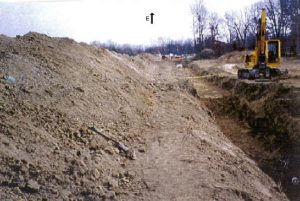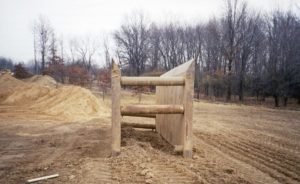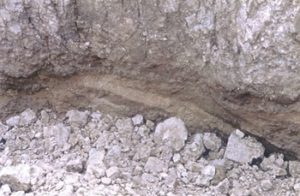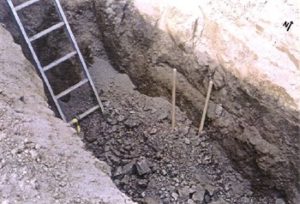17-Year-Old Laborer Works His Last Day
A 17-year-old male laborer died, and a co-worker was injured after a wall in the trench they were working in collapsed. The victim was part of a crew installing sewer pipes at an industrial park development (Figure 1).

Sewer Installation Project (Trench pictured
is approximately 200 feet long.)
The crew consisted of five men including the victim and a self-employed excavator operator. The day before the incident, the excavator operator removed the trench shield (Figure 2), so he could pull out old pipes. Once this was done the crew quit work for the day.

Figure 2. Shield (Shield was removed from the trench
with an excavator and placed 20 yards from the trench.)
When work resumed at approximately 7:30 a.m. the next morning, the excavator operator removed the broken pipe. He did not replace the trench shield before he lowered new sections of pipe into the trench. He then waited nearby with the hydraulic excavator running since his next task, after the line was repaired and properly aligned, would have been to lower a cement manhole into place.
The victim and a co-worker (pipe setter) went into the unprotected trench (11 feet deep x 8 feet wide) to set the two new sections of pipe.
After they had set the pipe, a co-worker, working above them at ground level, handed them a grade pole. While they were placing the grade pole inside the end of the pipe to allow them to check the grade of the sewer line, a section of the unprotected trench wall 30 feet long by 11 feet high and several feet thick caved in (see Figure 3). A portion of this fallen section struck the victim and his co-worker, burying the victim up to his mid-chest and his co-worker up to his knees (see Figure 4).

Figure 3. Cave-In Area (Looking South, cave-in area
is approximately 30 feet long and 11 to 13 feet deep.)

Figure 4. Incident Scene (The victim and his co-worker
were buried near the west end of the trench.)
Within 22 minutes of calling 911 and before protective systems had been placed in the trench by fire fighters, co-workers freed both workers. The injured workers were treated by paramedics and transported via ambulance to a local hospital.
The injured co-worker was admitted in serious condition and subsequently recovered. The victim underwent emergency surgery, experienced a cardiac arrest, and died at 2:03 p.m., approximately 5 hours following the incident. The Medical Examiner listed the cause of death as abdominal trauma.
Final Word
This is a tragic example of a life cut short because safety procedures weren’t followed.
- Employers must know and comply with labor laws. The victim was 17.
- In the U.S., employers are prohibited from employing persons less than 18 years of age for excavation work, including working in or backfilling trenches 4 feet deep or greater at any point. In Canada, many provinces prohibit such work being done by those 16 and younger.
- As a young worker, the victim may not have known or understood the gravity of the situation. If he did, he likely didn’t speak up because of his age and lack of experience.
- The excavation had been properly protected by a heavy-duty trench shield during the work leading up to the event. But for some reason, the excavator operator and the foreman, who was also likely the competent person on site, carried on work without putting the shield back in the trench.
- When work conditions change and necessitate the temporary removal of the protective system in use, employers must ensure that all workers are removed from the trench. Only when an appropriate protective system is again placed in the trench should workers be allowed to reenter the trench.
- All workers should be trained on hazard recognition and avoidance of unsafe conditions.
- Young workers should receive training on prohibited work tasks and settings (activities deemed to be especially dangerous for youths by the employer and/or child labor regulations), as well as hazards and safe work practices that apply to work they are permitted to perform.
Trenching and excavation work is some of the most dangerous work there is. No worker, regardless of their age, should be working in an unprotected excavation.